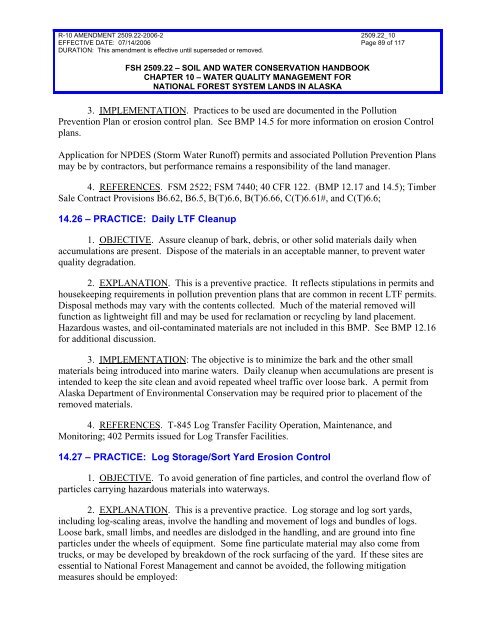Transportation & Other Facilities Management - USDA Forest Service
Transportation & Other Facilities Management - USDA Forest Service
Transportation & Other Facilities Management - USDA Forest Service
You also want an ePaper? Increase the reach of your titles
YUMPU automatically turns print PDFs into web optimized ePapers that Google loves.
R-10 AMENDMENT 2509.22-2006-2<br />
EFFECTIVE DATE: 07/14/2006<br />
DURATION: This amendment is effective until superseded or removed.<br />
FSH 2509.22 – SOIL AND WATER CONSERVATION HANDBOOK<br />
CHAPTER 10 – WATER QUALITY MANAGEMENT FOR<br />
NATIONAL FOREST SYSTEM LANDS IN ALASKA<br />
2509.22_10<br />
Page 89 of 117<br />
3. IMPLEMENTATION. Practices to be used are documented in the Pollution<br />
Prevention Plan or erosion control plan. See BMP 14.5 for more information on erosion Control<br />
plans.<br />
Application for NPDES (Storm Water Runoff) permits and associated Pollution Prevention Plans<br />
may be by contractors, but performance remains a responsibility of the land manager.<br />
4. REFERENCES. FSM 2522; FSM 7440; 40 CFR 122. (BMP 12.17 and 14.5); Timber<br />
Sale Contract Provisions B6.62, B6.5, B(T)6.6, B(T)6.66, C(T)6.61#, and C(T)6.6;<br />
14.26 – PRACTICE: Daily LTF Cleanup<br />
1. OBJECTIVE. Assure cleanup of bark, debris, or other solid materials daily when<br />
accumulations are present. Dispose of the materials in an acceptable manner, to prevent water<br />
quality degradation.<br />
2. EXPLANATION. This is a preventive practice. It reflects stipulations in permits and<br />
housekeeping requirements in pollution prevention plans that are common in recent LTF permits.<br />
Disposal methods may vary with the contents collected. Much of the material removed will<br />
function as lightweight fill and may be used for reclamation or recycling by land placement.<br />
Hazardous wastes, and oil-contaminated materials are not included in this BMP. See BMP 12.16<br />
for additional discussion.<br />
3. IMPLEMENTATION: The objective is to minimize the bark and the other small<br />
materials being introduced into marine waters. Daily cleanup when accumulations are present is<br />
intended to keep the site clean and avoid repeated wheel traffic over loose bark. A permit from<br />
Alaska Department of Environmental Conservation may be required prior to placement of the<br />
removed materials.<br />
4. REFERENCES. T-845 Log Transfer Facility Operation, Maintenance, and<br />
Monitoring; 402 Permits issued for Log Transfer <strong>Facilities</strong>.<br />
14.27 – PRACTICE: Log Storage/Sort Yard Erosion Control<br />
1. OBJECTIVE. To avoid generation of fine particles, and control the overland flow of<br />
particles carrying hazardous materials into waterways.<br />
2. EXPLANATION. This is a preventive practice. Log storage and log sort yards,<br />
including log-scaling areas, involve the handling and movement of logs and bundles of logs.<br />
Loose bark, small limbs, and needles are dislodged in the handling, and are ground into fine<br />
particles under the wheels of equipment. Some fine particulate material may also come from<br />
trucks, or may be developed by breakdown of the rock surfacing of the yard. If these sites are<br />
essential to National <strong>Forest</strong> <strong>Management</strong> and cannot be avoided, the following mitigation<br />
measures should be employed:

















